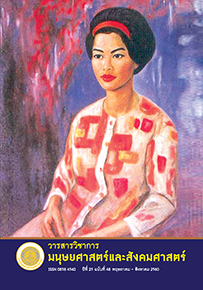ชุมชนบ้านชากแง้ว: การฟื้นฟูและการดำรงอยู่ (พ.ศ. 2552-2558) Ban Chak-Ngaew Community: Reconstruction and Existence (A.D. 2009-2015)
Main Article Content
Abstract
บทคัดย่อ
การวิจัยครั้งนี้มีวัตถุประสงค์เพื่อศึกษาต้นทุนของชุมชนบ้านชากแง้ว ปัจจัยภายนอกและผลกระทบที่มีต่อการเปลี่ยนแปลงของชุมชน รวมถึงเสนอแนะแนวทางการฟื้นฟูและดำรงอยู่อย่างยั่งยืนของชุมชน การศึกษาใช้ระเบียบวิธีวิจัยเชิงคุณภาพ โดยวิธีการรวบรวมข้อมูลแบบเน้นการสังเกตและการสัมภาษณ์เชิงลึกเป็นหลัก ผลการศึกษาพบว่า ต้นทุนของชุมชนบ้านชากแง้วซึ่งเป็นมูลค่าของชุมชนประกอบด้วย เรื่องราวประวัติความเป็นมา ความเชื่อพิธีกรรม และวัฒนธรรมประเพณีสถาปัตยกรรมที่มีความเฉพาะทางกายภาพ ภูมิปัญญาด้านอาหารการกิน และความสัมพันธ์ของคนในชุมชน ปัจจัยภายนอกซึ่งสามารถสร้างประโยชน์ให้แก่ชุมชนประกอบด้วยยุทธศาสตร์ นโยบายและแผนพัฒนาต่าง ๆ ที่เกี่ยวข้องทั้งระดับชาติและพื้นที่ รัฐบาลและหน่วยงานต่าง ๆ และการเปลี่ยนแปลงเทคโนโลยีสารสนเทศ
ผลกระทบที่มีต่อการเปลี่ยนแปลงของชุมชน ได้แก่ ชุมชนได้จัดถนนคนเดินตลาดจีนโบราณ ซึ่งถือว่าประสบความสำเร็จในการจัดการท่องเที่ยวโดยชุมชน โดยมีผลกระทบเชิงบวกทั้งด้านเศรษฐกิจ สังคม สิ่งแวดล้อม คุณภาพชีวิต อารมณ์จิตใจและการอนุรักษ์วัฒนธรรม ในประเด็นการฟื้นฟูและดำรงอยู่อย่างยั่งยืนของชุมชนผู้วิจัยได้เสนอแนะแนวทางเป็น 4 ด้าน ได้แก่ การพัฒนาด้านกายภาพ ด้านสังคมวัฒนธรรม ด้านกิจกรรม และด้านการบริหารจัดการผ่านการมีส่วนร่วมของชุมชน
Abstract
This research aimed 1) to study the capital of Ban Chak-Ngaew community; 2) to study external factors and their impacts on community change; and 3) to propose a guideline for reconstruction and sustainable existence. This qualitative research relied mostly on observationand in-depth interview as data collecting tools. The results showed that the community capital of Ban Chak-Ngaew consisted of its historical background, beliefs, ritual, tradition, physically Unique architecture, gastronomy wisdom, and relation of community members. The beneficial external factors included strategy, policy, and national and local level development plans, the government, related organizations, and informatics technology.
Ancient Chinese-styled walking street was promoted and this promotion empowered the community in terms of economy, society, environment, quality of life, psychology, and cultural conservation. For the reconstruction and sustainable revival guideline, four aspects of development had to be encouraged. The 4 aspects included physical appearance, cultural and social development, activity, and management with community participation.
Downloads
Article Details
บทความทุกบทความเป็นลิขสิทธิ์ของวารสารวิชาการมนุษยศาสตร์และสังคมศาสตร์ มหาวิทยาลัยบูรพาเท่านั้น


